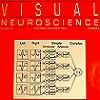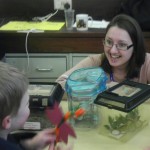This has been an exceptionally good and fun week doing the British Science Festival. Lisa had set up a workshop all on camouflage and mimicry and during all the lab helped out (although kudos to Lisa who managed to do every session with a big smile on her face!). There were lots of different activities to do during the workshop including a load of real life creepy crawlies that were all experts at camouflage. My task was to take the children through some posters and do some questions on a quiz sheet. The first question was to do with mimicry. I explained that a hoverfly pretends to be a wasp so that it doesn’t get eaten by birds and we had three example hoverflies from different species trying to mimic a wasp. The children had to rank them in order of ‘most waspishness’ and everybody agreed one was rubbish, one was good, and one was OK. They found it very interesting that birds actually saw our OK mimic as a good mimic and our good mimic as an OK one, and some even ventured a guess that it meant birds see things differently from ours.
Next up on the quiz was aposematism. For those that don’t know, aposematism is the act of being very bright and colourful to warn predators away from eating them, we had examples such as a bee (black and yellow, ‘I’ve got a stinger leave me alone’), a poison arrow frog (Black and yellow patterns ‘don’t eat me I’m poisonous’) and the bombardier beetle (red and black ‘don’t eat me or I’ll spray you with a horrible stink, the kids particularly loved this one!). As a group we then discussed other aposmatic creatures. I had some very interesting answers, of which most were brightly coloured but more to stay camouflaged (tiger, zebra and clown fish). I had some that were mimics or dangerous in their own way (milk snake and sea anemone) and some really good answers (ladybird, skunk, wasp, ringed octopus).
The final two questions involved matching the creature to the type of camouflage it was using, and then guessing which out of 14 butterflies were poisonous and tasty. After the quiz was finished the kids rotated and did something else in the room (which you will probably hear about in other blog posts) and I started again with the next group.
The entire workshop was a great success and I really think some kids took some real knowledge and interest away from the day, and I heard more than one say it had been the best one they had seen yet. Very pleased I volunteered to help out with the event!































